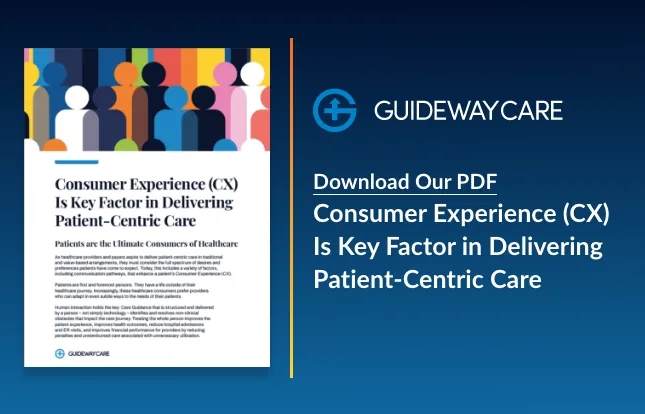Care Guidance Helps Reduce Preventable Readmissions Among Multi-Visit Patients

Key Points
- Multi-visit patients account for more than half of all readmissions in the United States
- Readmission risks are higher for patients facing health inequities attributed to SDoH
- Care Guidance activates patients to identify and promptly resolve their disparities before becoming problematic, requiring readmission
Patients who are high utilizers of healthcare services, also known as multi-visit patients (MVPs) or frequent flyers, statistically drive up readmission rates and strain clinical resources of hospitals and emergency departments. Multi-visit patients account for more than half of all readmissions in the United States.
Readmission costs to Medicare is reported at $26 billion annually, with $17 billion of that amount spent on avoidable hospital intakes and readmissions after discharge, according to data from the Center for Health Information and Analysis. Furthermore, preventable readmissions erode quality-of-care and can result in financial penalties and claim denials.
On a special bonus episode of the Race to Value podcast, Amy Boutwell, MD, MPP, a nationally recognized thought leader in the field of reducing readmissions and improving care for highest risk and multi-visit patients, states, “We must walk away from the dogma that it is not worth serving high utilizers. The industry must reengineer its thinking around that to advance health equity.
To drive processes that improve care and reduce unnecessary readmissions, Medicare instituted the Hospital Readmissions Reduction Program (HRRP), which reduces payments to organizations with excess readmissions. For these reasons, many hospitals are implementing organization-wide programs and policies aimed at reducing hospital readmissions.
“Guideway Care successfully supports hospitals and provider groups who participate in HRRP by working to reduce unnecessary readmissions attributed to socioeconomic disparities experienced by at-risk patients,” says Mark Lloyd, vice president of business development, Guideway Care. “The use of our care guides effectively activate patients to identify and resolve their non-clinical barriers to continued care, while also enhancing their overall care experience with positive outcomes. Our care guidance approach is proven to reduce readmissions, including 31% reductions in CHF readmissions and 41% reductions in COPD readmissions.”
Studies indicate that readmission risks are higher for patients facing health inequities attributed to socioeconomic characteristics. For example, according to CMS, minority and other vulnerable populations are more likely to be readmitted within 30 days of discharge for chronic conditions. The most common cause of preventable readmission is disengagement and non-compliance. Disengagement is a patient’s unwillingness to follow discharge instructions or unwillingness to participate in their continuation of care, and non-compliance means they are not adhering to their treatment plan.
Underlying Cause – Non-Clinical Issues Attributed to Social Determinants
Hospitals and providers must consider the full spectrum of a patient’s health and socioeconomic conditions that impact their willingness and ability to access, receive and adhere to care. If these issues are not addressed and resolved, they can lead to health deterioration, extended hospitalizations and readmissions.
Characterized as social determinants of health (SDoH), these non-clinical factors include food and nutrition, transportation, social and economic stability, education and environmental conditions. SDoH exist at the individual patient level and within communities, typically falling outside of the health system’s visibility and control. Patients who are at risk of SDoH-driven disparities typically require higher levels of activation and monitoring beyond the provider’s focus on clinical care. This is especially true with patient transitions from the hospital or care facility to home-based care.
To support an equitable path forward for all patients, health systems are employing patient advocates and navigators whose scope is focused on communicating with and activating patients to identify and promptly resolve their disparities – before becoming problematic, requiring readmission.
Guiding the Future of Equitable Healthcare
Sidebar Callout: Guideway’s Care Guidance services are proven to reduce readmissions, including 31% reductions in CHF readmissions and 41% reductions in COPD readmissions.
Guideway Care partners with health systems, hospitals and providers through an integrated care guidance program driven by a shared objective of improving health equity. Highly trained “Care Guides”’ activate patients through a combination of human engagement, technical innovation and workflow protocols that proactively uncovers and resolves disparities that pose barriers to care access and delivery – risk factors that potentially lead to avoidable health deterioration, utilization and readmissions.
Clinical staff receive the extended support they need to ensure the delivery of equitable care that optimizes patient experience, satisfaction and generates the best possible outcomes. This is where the proposition of care guidance presents the most value to all shareholders.
Contact us for insight into how Guideway Care, as your partner, can implement an efficient and effective care guide solution to support your clinical team and deliver on the promise of health equity based on the needs of the patient populations in your community.
Contact Us Today To Learn How We Can Help
"*" indicates required fields




